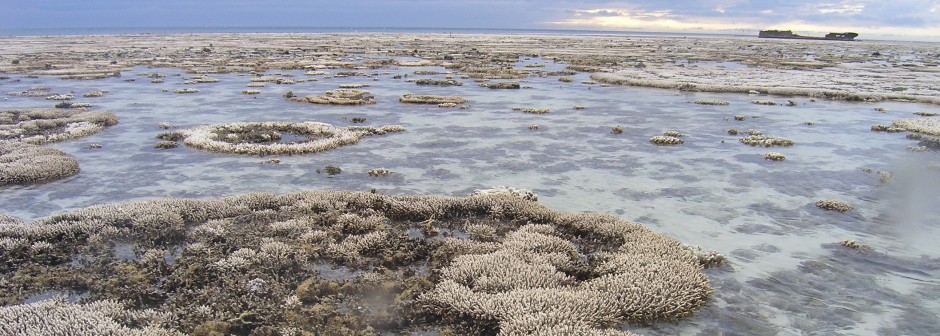Think of the most beautiful natural environment you can. The place where you would just stand there, in awe of the sights before you. If you are like most people, you likely pictured a coral reef. Their stunning array of marine organisms, all fitting into their ecological niches, is truly a sight to behold. The island nation of Kiribati is no exception. It consists of a collection of 33 atolls, 21 of which are inhabited. They are located just west of the International Date Line (6).
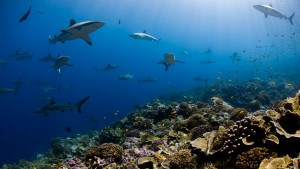
Figure 1. “Sharks swim of a pristine reef at Millennium Atoll in the southern Line Islands, Kiribati.” (7)
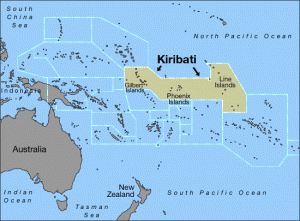
Figure 2. Map of Kiribati, showing three groups of Islands. These are the Gilbert, Phoenix, and Line Islands. (2).
Unfortunately for Kiribati, it is extremely vulnerable to the effects of climate change. Already, rising sea levels are having detrimental effects on the island nation. Studies have shown that global sea levels have risen by approximately eight to ten inches since 1880. Some projections have indicated that sea levels may rise by three feet by 2100. Kiribati could become the first nation for face a refugee crisis due to climate change (1).
However, the potential social and economic problems that Kiribati faces due to the climate change are not the whole picture. Other effects of climate change will have drastic effects on the surrounding coral communities. Rising sea temperatures have repeatedly been connected to coral bleaching events. This produces biological stress that causes their symbiotic algae to be expelled (6). This process is known as coral bleaching and it is a worldwide ecological phenomenon. When these symbiotic algae are expelled, the corals lose the benefits for their biological relationship. This has cascading effects on the rest of the coral reef ecosystem, thus destabilizing a whole region (5).
NOAA, the National Oceanic and Atmospheric Administration, has identified the third global coral bleaching event (4). Using a synthesis of their climatic data, the organization has created predictions for the threat levels of global coral reefs. While Kiribati does not seem to be in grave danger in the 4-month bleaching outlook, they do have Alert Level 1 status in the extended bleaching prediction.
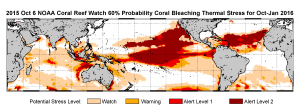
Figure 3. “NOAA’s standard 4-month bleaching outlook shows a threat of bleaching continuing in the Caribbean, Hawaii and Kiribati, and potentially expanding into the Republic of the Marshall Islands.” (3)
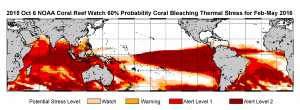
Figure 4. “An extended bleaching outlook showing the threat of bleaching expected in Kiribati, Galapagos Islands, the South Pacific, especially east of the dateline and perhaps affecting Polynesia, and most coral reef regions in the Indian Ocean.” (3)
Interestingly, there has been some evidence that the islands of Kiribati are fairing better than some of their nearby counterparts. This may be due to a cool current that specifically targets this area. While it is not thought that that this current will save corals from the global bleaching event, it may slow the process to a point where intervention may have a chance (5). Read the next entry of this blog to find out how these changes have affected the Kiribati Island reefs!
References
- Davenport, C. (n.d.). Rising Seas. The New York Times. Retrieved February 17, 2016, from http://www.nytimes.com/interactive/2014/03/27/world/climate-rising-seas.html?_r=0
- Map of Kiribati. (n.d.). Retrieved February 17, 2016, from http://www.climate.gov.ki/wp-content/uploads/2012/10/map_kiribati.gif
- NOAA Bleaching Predictions. (n.d.). Retrieved February 17, 2016, from http://www.noaanews.noaa.gov/stories2015/100815-noaa-declares-third-ever-global-coral-bleaching-event.html
- NOAA declares third ever global coral bleaching event. (n.d.). Retrieved February 17, 2016, from http://www.noaanews.noaa.gov/stories2015/100815-noaa-declares-third-ever-global-coral-bleaching-event.html
- Pacific Islands Protect Coral Reefs from Bleaching. (n.d.). Retrieved February 17, 2016, from http://www.pri.org/stories/2012-06-28/pacific-islands-protect-coral-reefs-bleaching
- Rising Sea Level in the Republic of Kiribati | Global Warming Effects. (n.d.). Retrieved February 17, 2016, from http://www.climatehotmap.org/global-warming-locations/republic-of-kiribati.html
- Sharks Over Millennium Atoll. (n.d.). Retrieved February 17, 2016, from http://blogs.ei.columbia.edu/2015/08/17/can-we-save-coral-reefs/

